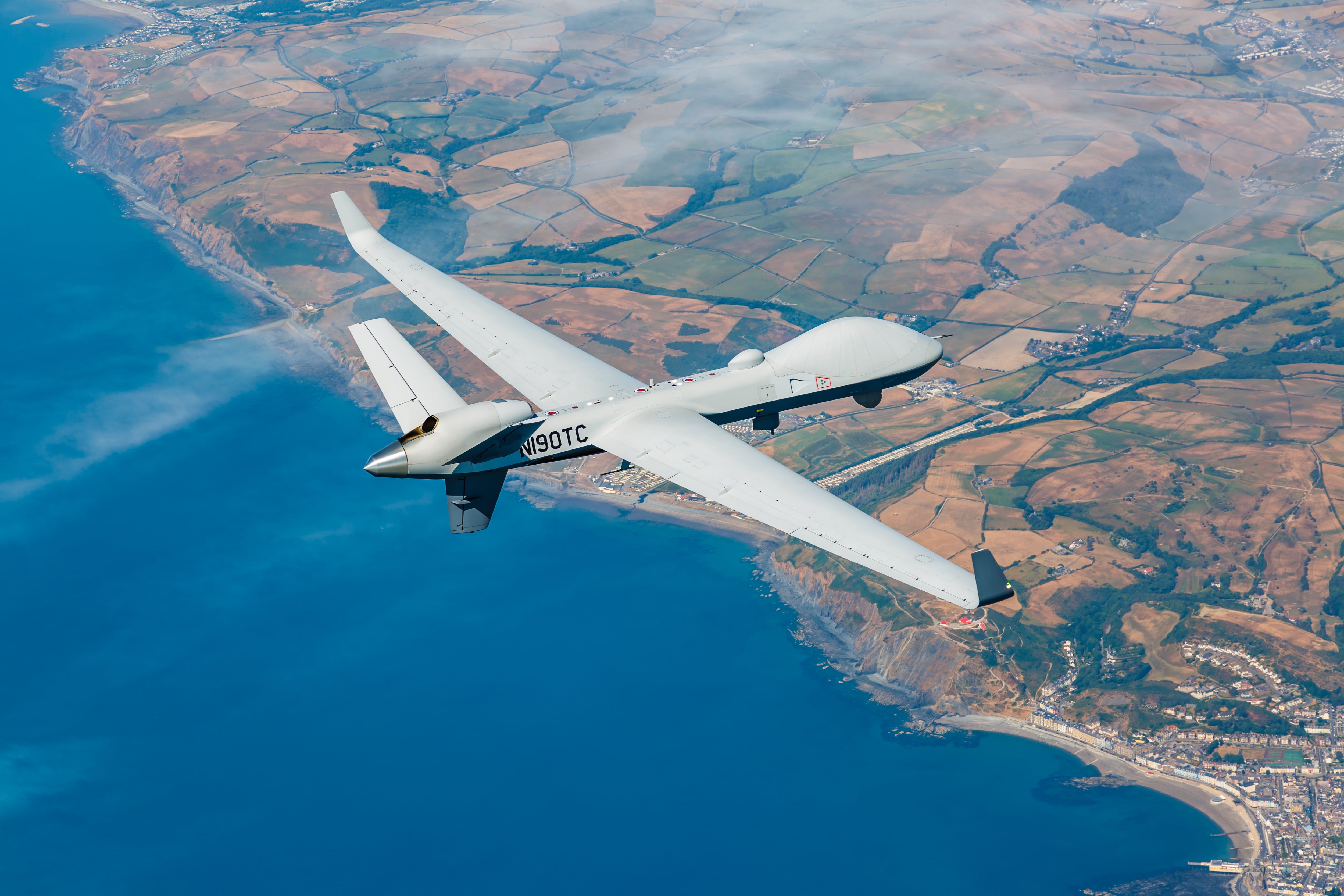In July 2018, a remotely piloted aircraft – the MQ-9B SkyGuardian – flew from the United States to the United Kingdom, landing after a 24-hour trans-Atlantic flight using the same routes as manned aircraft. It was a first in the world of medium-altitude, long-endurance RPA. But it also foreshadows how ongoing and future MALE RPA concepts of operations will evolve.
The unmanned aircraft revolution is inexorably underway thanks to six new capabilities.
- SATCOM auto-land. MQ-9B demonstrates that it is now possible to deploy a multi-sensor intelligence, surveillance and reconnaissance (ISR) capability thousands of miles from its home base. With the only requirement being a small team of technicians on the deployment field, there’s no longer a need to dismantle the aircraft and ship the entire system. This facilitates the availability and initial ISR capability in emergency missions at home or abroad.
In 2006, during the evacuation of European Union (EU) nationals from Lebanon, an MQ-9B could have taken off from France, flown safely over the Mediterranean and provided 25 hours or more of ISR support to the extraction task force before landing in Cyprus. A team of three technicians with a laptop arriving on a commercial flight could ensure refuelling and SATCOM reconnection of the aircraft. Once completed, the RPA could fly for an additional 40 hours. With this capability, every existing airfield in the area of operations becomes a potential diversion site in case of weather or technical problems. Again, a core weakness that once complicated operations is now overcome.
- Detect and avoid. The MQ-9B is equipped with an airborne detect and avoid system that includes an air-air radar and a traffic collision and avoidance system that offers a significant alternative to the traditional rule of see and avoid. Despite years of research, the development of DAA systems was mired in technical and regulatory challenges. That is no longer the case, as several companies are working with regulators around the world to field standards-compliant DAA systems. By integrating TCAS II and ADS-B, the unmanned aircraft will perform like any modern aircraft with automatic collision avoidance against cooperative (transponder equipped) aircraft. This improvement to MQ-9B, coupled with protections against icing and lightning, has a major operational benefit: it enables standard flight rules and procedures to be applied throughout the airspace without having to uniquely separate the manned aircraft with those piloted remotely.
- Redundancy of the main satellite link. The redundancy of the primary beyond line of sight (BLOS) link with a secondary satellite link operating in another frequency band ensures the continuation of the mission by permanently maintaining the piloting capabilities, even in the event of interference. Satellite data links, a true digital umbilical cord, are used to control the RPA, operate on-board sensors, and disseminate the ISR data collected from the aircraft to the cockpit. The disconnection of this link, although rare, reveals a true weakness, especially when the aircraft operate in a non-segregated environment or during bad weather. However, with a second satellite link, the aircraft will now remain in control of the remote pilot and will either continue its mission safely or land without issue. This helps make these aircraft perfectly suitable for flight in civilian airspace.
- Certification. The next years will bring the advent of unmanned aircraft built to civilian aircraft standards. Initially conceived to fill surveillance and combat roles, the use of large RPA remained limited to the “dirty, dull and dangerous” missions. The demands of European customers in particular have forced Israeli and U.S. RPA manufacturers to take these airworthiness requirements into account to compete in the EU market and obtain contracts. These new, certifiable unmanned aircraft allow us to consider their unrestricted use on domestic airspace in support of counter-terrorism missions, as well as those that contribute to the protection of citizens.
- Sensor modularity. Modern RPA will allow more sensors to be integrated according to customer needs. The ISR omni-role platform will be plug-and-play and “sensors agnostic.” As aircraft allow for constant monitoring of a target and its environment, it is necessary to capitalize on that through the modularity of sensors ideally without hampering endurance. Sensor variety ranges from traditional real-time high-definition cameras (FMVs) to multi-mode radars to a wide range of guided weapons and multi-intelligence sensors (COMINT, ELINT, WAMI, hyperspectral, EW, buoys, anti-submarine warfare). The challenge is to provide the operator with the opportunity, for obvious questions of sovereignty, to be able to quickly obtain integration of his own weapons and sensor suites. This flexible plug-and-play capacity to perform sovereign missions with a wide variety of sensors of national origin will be a considerable step forward.
Technology will no doubt continue to facilitate the use of MALE RPA like any manned aircraft. It eliminates most, if not all, current operational constraints. The emergence of this new generation of aircraft will satisfy the requirements of persistence, precision and time contraction across the full spectrum of defence and homeland missions. The significant increase in endurance will offer “occupation of the airspace” over a target and its environment, as time on station will be counted in days and no longer in hours.
However, it should be noted that “There is nothing more manned than an unmanned system.” Therefore, the introduction of automation will first affect data analysis, then assistance in flying multiple aircraft. It’s the next step of the ongoing revolution. Paradoxically, it may be remotely piloted, AI-augmented manned aircraft that lend strength to the prophetic quotation of Clement Ader, “He who will master the air will master the world.”
Christophe “Taraz” Fontaine is the director of strategic development for Europe at General Atomics Aeronautical Systems, Inc. He served 30 years in the French Air Force and was the first French MQ-9 Reaper squadron commander.








